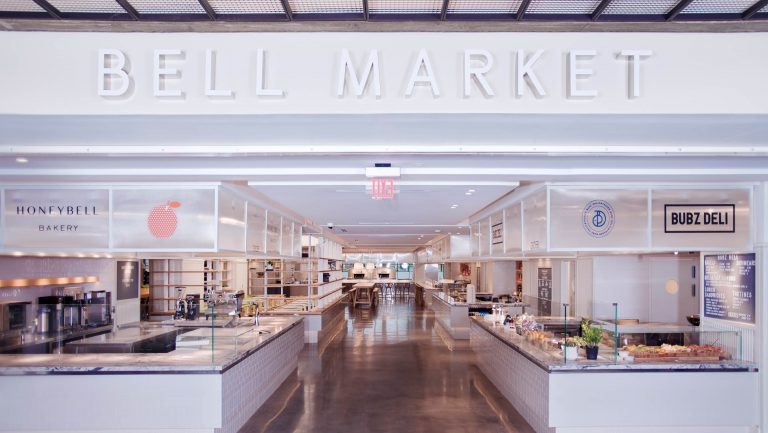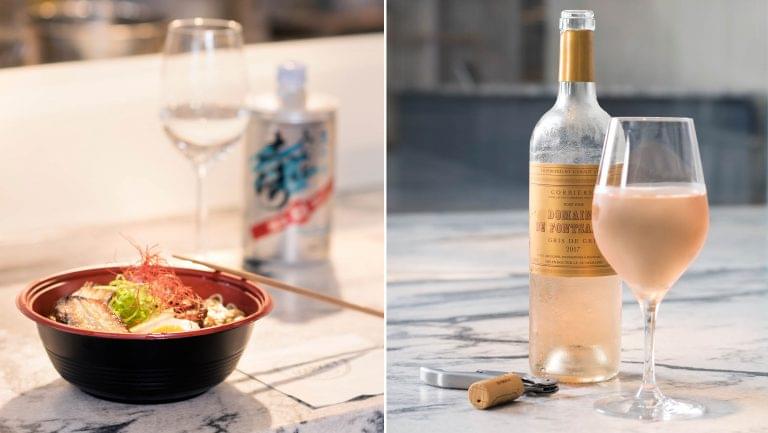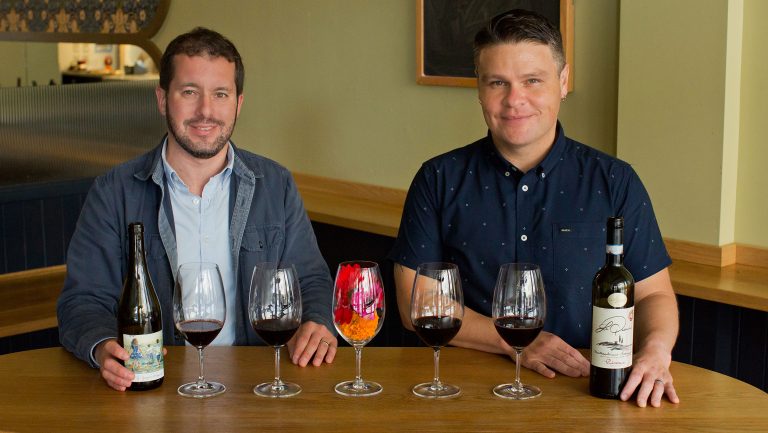Gourmet food halls continue to gain in popularity, with projects large and small opening from coast to coast. While the “everything under one roof” model remains typical, a recent wave of halls have emphasized specific types of cuisine, a more carefully curated selection of vendors, and a more unified drinks program.
Designing and executing a beverage program in the food hall environment is a different kind of challenge for beverage managers. Planning a program for such venues requires that a manager take into account high-volume crowds, a range of dining experiences, and often, a more diverse client base than a standard restaurant. SevenFifty Daily spoke with four beverage managers at food halls around the country—Great Northern Food Hall in Grand Central Station in Manhattan; China Live in San Francisco; Bell Market in Holmdel, New Jersey; and Detroit Shipping Company in Detroit—to get a better understanding of the challenges, the strategies they’ve implemented to achieve success, and their tips for those making moves into the food hall beverage space.
Know Your Demographic
Whatever the food hall—whether it’s the hyperfocused, inspired by all things Nordic Great Northern Food Hall or the Detroit Shipping Company, the city’s first food hall—beverage managers can just about guarantee that the client base will be diverse. “It’s such a mixed bag,” says Lauren McDougall, the manager at Great Northern, a small food hall tucked into Grand Central Station that combines seven specialty food outlets—including a coffee roaster, bakery, grain bar, deli, hot dog stand, grab-and-go deli—alongside The Bar, which serves cocktails, beer, wine, and food.

Don’t miss the latest drinks industry news and insights. Sign up for our award-winning newsletters and get insider intel, resources, and trends delivered to your inbox every week.
McDougall’s cocktails have an intentionally Nordic slant—substituting aquavit for gin, for example, or using a Nordic fruit as a garnish—but she makes a point of keeping the drinks traditional enough to be recognizable to a variety of guests. “We get everything from commuters looking to grab a good IPA to tourists who have come specifically to see what we’re up to. So we try to accommodate everyone—we want to pique interest but not exclude anyone.”
Inclusivity is huge, says Petro Drakopoulos, an operating partner of the Detroit Shipping Company, which opened in the middle of July and features three diverse food concepts—tacos, Thai street food, and Caribbean fusion (three more vendors are forthcoming). Drakopoulos oversees one program for the entire food hall, and he notes that approachability is his priority when planning drinks. “You need to program your space to be something for the community,” he says. “Even if you’re counting on bringing in people from other cities, or surrounding towns, your offerings ultimately need to serve the people in your community. They’re the ones who are going to support you through thick and thin and allow you to be successful.”

Price Competitively
This diversity in client base should also be reflected in your menu pricing. Chantelle Corbo, a partner in the newly opened Bell Market, as well as its beverage director, knew that this would be a major focus when planning the offerings for the food hall, which includes five food concepts—a Jewish deli, a salad restaurant, a bakery, a Japanese restaurant, and an Italian restaurant centered on two wood-burning pizza ovens—and one beverage program for the entire market, which she oversees.
“I certainly had more flexibility with wine programs I planned in the past—in terms of having more vintages and higher price points,” says Corbo, who is also a certified level-two sommelier with the Court of Master Sommeliers. “With Bell Market, quality offerings and approachable prices are both top considerations.”
It’s essential to keep pricing approachable, says Drakopoulos. At Detroit Shipping Company, such pricing means, for example, not offering $20 glasses of wine. But Drakopoulos adds that making your drinks menus interesting and dynamic is just as important. Calvin Young, the general manager at China Live, takes that ethos to heart for his menus’ beer, wine, and cocktails. “We walk that line between casual and semi-upscale,” he says, “and having that versatility is really nice. I make sure to design cocktails to fit that profile. We want drinks to be fun.” But, he adds, he doesn’t want the cocktails to be super esoteric either. Take the Shanghai Noon, a blend of vodka, 8 Treasures tea syrup, crème de violette, and a Szechuan peppercorn tincture, topped with bubbles. The flavor profile is vibrant with a mix of flavors, but the drink is approachable—spritzy and refreshing with a bit of a kick. “We’re appealing to the masses but creating something that your savvy local drinker will enjoy, too.”
Plan for Volume
The “masses” are a key consideration when planning beverage programs for food halls. Preparing for a large and varied clientele is perhaps one of the most significant steps a beverage manager at a food hall can take.
“We’ll seat 100 people within 20 minutes, and the drinks are going like crazy,” says Young. Much of China Live’s beverage program centers on cocktails. With an eye toward fast and efficient service, the menu features cocktails on draft, as well as cocktails with multiple ingredients that can be batch-made ahead of time. “Ninety percent of it is foresight and preparation,” Young says. “Your lab work, if you will.”
Drakopoulos agrees that keeping up the pace is crucial. During the Detroit Shipping Company’s opening weeks, he says, there was a bar rush that could “rival a stadium crowd.” His cocktail program similarly revolves around batch-made ingredients. He makes five cocktails available every day, and he’ll rotate them in and out of the daily list based on what infusions are ready.
The need for speed and accessibility is no excuse to be boring, though. Young’s program is designed to pair with China Live’s Chinese food offerings; the drinks menu includes an extensive selection of wines by the glass and the bottle, four craft beers, five nonalcoholic cocktails, a dozen Chinese teas, and 8 to 10 cocktails that change seasonally. Young creates cocktails that contain ingredients that complement the hall’s extensive Chinese food menus, including dried mushrooms, chiles, and spices. Similarly, Bell Market’s cocktails offer seasonality, often featuring garnishes and ingredients from the farmers’ market hosted right outside the food hall.
Batching is one approach to serving a large and continuous crowd, but it’s not always necessary. McDougall’s Great Northern menu features made-to-order cocktails almost exclusively, though there is a barrel-aged Negroni on offer. “We do get good volume,” McDougall says, “but we have quick bartenders.”
Stay Focused and Stay Agile
A cohesive plan for your beverage program, with built-in flexibility, helps ensure success. Corbo says she started mapping out Bell Market’s program back in the design phase, almost two years ago. It included her dream lists for wine, beer, and cocktails—and she worked backwards from there. She was always focused on a global wine list, with a few favorite small producers and some natural wines.

Today, Corbo’s list features about 50 bottles, ranging from a $34 Domaine de la Chanteleuserie to a $115 Pierre Peters Champagne Cuvée de Reserve, though the majority of the bottles on the list are under $50. Additionally, 10 wines are available by the glass, ranging from $7 to $11. While much of the list is tailored to pair with the cuisine of Corbo & Sons, Bell Market’s Italian restaurant, the wines are also available—along with a selection of sake and beer—at Jozu, the market’s Japanese food outpost. Corbo notes that she’s currently working on building out the Italian portion of her wine list with an eye toward selections that will pair fluidly with both Italian and Japanese cuisine.
“Being able to switch gears to another alter ego, from Italian to Japanese, is incredibly fun as a buyer,” she says. “You get to change wine-pairing hats—sashimi, hand rolls, ramen, and robatayaki skewers open up a world of wine possibilities, like Rieslings from Alsace, Germany, and Austria; Chenin from the Loire Valley; Grüner Veltliners from Austria; Sémillon and Sémillon–Sauvignon Blanc blends from Australia; Malvasia from Croatia; and Champagne.”
McDougall’s plan was more specific: Great Northern offers Nordic-inspired cuisine that showcases ingredients and products from local and regional producers whenever possible. Everything—beers, wines, and spirits—must be American, and preferably from New York. Her method for sourcing a rich list is to be transparent and clear in her communications about what she’s looking for. “I build good rapport with the reps I work with, so if they know of something I’m looking for, and I’m always very open about what that is—say, an American rye—even if it’s from a competitor, I’ll often get great leads from them.”
Young thinks that being thoughtful with the offerings and matching them to the environment in which your guests will be drinking is essential. “Tailor your drinks toward whatever food is being served and the environment in which you’re producing them,” he says. “If it’s going to be an upscale, fine-dining food hall, have your drinks match that. If it’s going to be super laid-back and relaxed, have your drinks match that as well.”
Detroit Shipping is Drakopoulos’s ninth large-volume food-and-beverage operation. His number one piece of advice to anyone starting a food hall beverage program is to allow time for the program to evolve. “I think the inclination can be to open with a grand vision,” he says, “and then you find yourself trimming it down from there.” Instead, he suggests, “start small and grow organically into who you are.”

Dispatch
Sign up for our award-winning newsletter
Don’t miss the latest drinks industry news and insights—delivered to your inbox every week.
Lauren Sloss is a San Francisco–based freelance writer who focuses on food, drink, and travel (in writing and in life). You’ll often find her drinking Syrah out of camping cups on Ocean Beach. Follow her on Instagram and at laurensloss.com.







